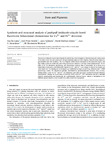Mostrar o rexistro simple do ítem
Synthesis and Structural Analysis of Push-Pull Imidazole-Triazole Based Fluorescent Bifunctional Chemosensor for CU2+ and FE2+ Detection
| dc.contributor.author | Da Lama Vázquez, Ana | |
| dc.contributor.author | Pérez Sestelo, José | |
| dc.contributor.author | Valencia, Laura | |
| dc.contributor.author | Esteban-Gómez, David | |
| dc.contributor.author | Sarandeses, Luis A. | |
| dc.contributor.author | Martínez, Montserrat | |
| dc.date.accessioned | 2023-02-02T20:10:48Z | |
| dc.date.available | 2023-02-02T20:10:48Z | |
| dc.date.issued | 2022-07 | |
| dc.identifier.citation | Ana Da Lama, José Pérez Sestelo, Laura Valencia, David Esteban-Gómez, Luis A. Sarandeses, M. Montserrat Martínez, Synthesis and structural analysis of push-pull imidazole-triazole based fluorescent bifunctional chemosensor for Cu2+ and Fe2+ detection, Dyes and Pigments, Volume 205, 2022, 110539, ISSN 0143-7208, https://doi.org/10.1016/j.dyepig.2022.110539. (https://www.sciencedirect.com/science/article/pii/S0143720822004612) | es_ES |
| dc.identifier.issn | 0143-7208 | |
| dc.identifier.uri | http://hdl.handle.net/2183/32428 | |
| dc.description.abstract | [Abstract] Fluorescent imidazole-triazole based ligands L1 and L2 have been designed as chemical push-pull chemosensors for divalent metal ions and synthesized through palladium-catalyzed cross-coupling reactions using indium organometallics and click chemistry. The novel ligands exhibit intense absorption in the ultraviolet region with high molar extinction coefficients, and strong fluorescence emission with large Stokes displacements. On the basis of UV–Vis absorption spectroscopy and fluorescence emission data in acetonitrile, L1 is shown as a bifuncional chemosensor with differential response for Fe2+ and Cu2+ over a range of selected 3d divalent and other metal ions. The binding site of the ligand was established by single-crystal X-ray diffraction and 1H NMR spectroscopy studies. The association constants, determined by spectrofluorimetric titrations, show a steady binding affinity of L1 for Cu2+ and Fe2+ in comparison with other previously reported fluorescent bidentate chemosensors, offering the lowest limit of detection (LOD) with Cu2+. DFT calculations provide a rationale properly understanding and interpreting the experimentally observed results. Indeed, a mechanism of the different optical responses of L1 towards 3d divalent metal ions is proposed. | es_ES |
| dc.description.sponsorship | We thank the Spanish Ministerio de Ciencia, Innovación y Universidades (PGC2018-097792-B-I00), Xunta de Galicia (GRC2018/039 and ED431B 2020/52) and EDRF funds for financial and human support. ADL thanks the Xunta de Galicia for a predoctoral fellowship (EDA 481A-2020/017). LV thanks CACTI for X-ray measurements | es_ES |
| dc.description.sponsorship | Xunta de Galicia; GRC2018/039 | es_ES |
| dc.description.sponsorship | Xunta de Galicia; ED431B 2020/52 | es_ES |
| dc.description.sponsorship | Xunta de Galicia; ED 481A-2020/017 | es_ES |
| dc.language.iso | eng | es_ES |
| dc.publisher | Elsevier | es_ES |
| dc.relation | info:eu-repo/grantAgreement/AEI/Plan Estatal de Investigación Científica y Técnica y de Innovación 2017-2020/PGC2018-097792-B-I00/ES/EL INDIO COMO HERRAMIENTA SINTETICA EN REACCIONES DE ACOPLAMIENTO Y EN CATALISIS/ | es_ES |
| dc.relation.uri | https://doi.org/10.1016/j.dyepig.2022.110539 | es_ES |
| dc.rights | Atribución-NoComercial-SinDerivadas 4.0 Internacional | es_ES |
| dc.rights.uri | http://creativecommons.org/licenses/by-nc-nd/4.0/ | * |
| dc.subject | Triorganoindium reagents | es_ES |
| dc.subject | Imidazole-triazole | es_ES |
| dc.subject | Fluorescent chemosensor | es_ES |
| dc.subject | Bifunctional chemosensor | es_ES |
| dc.title | Synthesis and Structural Analysis of Push-Pull Imidazole-Triazole Based Fluorescent Bifunctional Chemosensor for CU2+ and FE2+ Detection | es_ES |
| dc.type | info:eu-repo/semantics/article | es_ES |
| dc.rights.access | info:eu-repo/semantics/openAccess | es_ES |
| UDC.journalTitle | Dyes and Pigments | es_ES |
| UDC.volume | 205 | es_ES |
| UDC.issue | September | es_ES |
| UDC.startPage | 110539 | es_ES |
| dc.identifier.doi | 10.1016/j.dyepig.2022.110539 |
Ficheiros no ítem
Este ítem aparece na(s) seguinte(s) colección(s)
-
GI- Quimolmat - Artigos [102]
-
GI-REACT! - Artigos [107]






